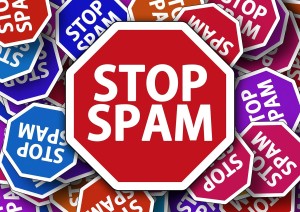Why You Need To Know Your SPAM rules

No-one likes spam, especially the Government! Don’t be caught out by SPAM laws
There is a problem with email marketing, and that is SPAM. The illicit and often annoying issue with email marketing can mean that your customers are turned away from email messages even if the problem is not you.
SPAM comes in many different forms. It can be an email message that was not requested, i.e. the recipient was added to a marketing list without their permission, or an email with a misleading subject line compared to their subject matter, or too many emails being sent.
Many of these SPAM activities are actually against the CAN-SPAM Act of 2003. In other countries, there are similar laws which generally contain the same rules. The laws do make it a little more difficult for you to send commercial emails, but it should give reassurance to customers and offers them a way to complain legitimately about companies who might send irrelevant or dangerous spam.
If you do break the law, there can be stiff fines. The CAN-SPAM Act of 2003 states that if you don’t follow the rules you can be fined up to $16,000 per violation per individual email. In the United Kingdom, the fine is smaller but still significant. Therefore, if you want the financial safety of your business, it’s best to follow the rules.
So what are the ten most important rules of these email marketing laws?
1. Signing Up
A prospect can subscribe to your email marketing list either by giving you verbal or written consent. On a website, this should include ticking a checkbox on a web form. It is also best practice to use the double opt-in sign-up system to ensure those signing up online actually know what they are signing up for.
2. Header Information
Recipients have the right to know who the email is from when it arrives in their inbox. Therefore, you can’t put in misleading or false information in the header. You should include information such as organisation domain name and email address as they appear in your business. It is best practice to have the domain name and sender as an actual person within the organisation.
3. Subject Lines
A good subject line can entice your audience into opening your email and looking at the offer you have inside. But the subject line has to reflect what the email is about. For instance, you can’t say they are getting something for free when you aren’t offering that at all.
4. Identifying Purpose
Customers have become wary of the tactics used by email marketers and therefore have developed a knowledge of when emails are ads. Marketers have since changed tactics to make it less obvious to get customers to re-engage with emails. While this has been effective, it is also against the CAN-SPAM laws. You need to ensure that your customers know that your message is an advert.
5. Location
Recipients need to know where your business is located. This is to demonstrate that you are a real company. To help build trust, ensure that the address of your organisation on the email is the same as the one on Google+.
6. Opting Out
It’s sad to see any subscriber leave your list, but you must give them the option which can either be done via an email message or a link within the email. The latter of these is the best option as it can mean that the process is automatic whereas the former creates more work for you.
7. Processing Opt-Out Requests
Every opt-out request you have from your subscribers needs to be processed quickly, within ten business days. You also need to honour requests from recipients up to 30 days after you’ve sent your email marketing message.
8. Third Party Involvement
If you have a digital marketing company run your email marketing campaigns, you must take responsibility for their actions as well. That is why it is so important that you get references for their work and check they are complying with email marketing laws.
9. Definition
These regulations only apply to commercial content; i.e. when you are promoting a product or service. Any emails that are sent for transactional or relationship reasons (i.e. invoices, warranty information, etc.) don’t have to follow the same rules. However, if you start adding commercial information to the emails, they are liable to follow the laws.
10. Forwarding
Sometimes it can be a great way to spread the word of your brand by asking current subscribers to forward your email to a friend. In these circumstances, you don’t need to worry about the CAN-SPAM laws unless you offer an incentive to send that email like a discount code.
Conclusion
It is crucial that you adhere to the CAN-SPAM Act. Failure to follow these rules can place your business at financial risk as well as annoy your potential customers. So ensure you know the rules and that you are following them.
Do you know your CAN-SPAM Act? Have you broken any of the rules above?
Let us know in the comments below.
Read post Post a Comment. Tagged in: email marketing laws, legal code, legal requirements, SPAM laws
Why You Need To Make It Easy For Your Subscribers To Unsubscribe
 No marketer wants to think about unsubscribers. After all, a person removing themselves off the mailing list is a lost opportunity for a sale and spread word about the brand. However, there will always be subscribers who want to leave your mailing list.
No marketer wants to think about unsubscribers. After all, a person removing themselves off the mailing list is a lost opportunity for a sale and spread word about the brand. However, there will always be subscribers who want to leave your mailing list.
When, not if, they want to unsubscribe, you will have to be prepared and make it as easy for the subscriber as it is for yourself. There shouldn’t be any lengthy process nor should the subscriber have to jump through hoops.
But why is this the case and what makes a subscriber want to leave your mailing list?
Why Would A Subscriber Want To Leave Your List?
There are numerous reasons why a subscriber might want to leave your mailing list. Here are the main reasons:
- They are no longer interested in your products: There are several reasons why this might be. They might not have the funds anymore or their priorities have changed. Alternatively, they have bought your product or a similar one from a competitor. There is no way to tell the true reason for this as these de-listings will happen sporadically.
- They think you are sending too many emails: This is when you send too many emails to your list and annoy them.
- They don’t remember subscribing to your list: This happens when you haven’t sent an email for a long time. Therefore, while it is important not to communicate too often; you should also ensure you keep in contact regularly enough that they remember who you are.
- Your content is not relevant: If you are not providing them with valuable content they can use, then they are likely to leave your list. In this case, you must adjust your strategy to provide something of worth.
In many of the cases you might not realise why they have left your list. However, if you’ve changed tactics recently, this can be a good indicator. Ensure that when you are adjusting campaigns that you check for changes in your standard statistics. For comparison, your email unsubscribe rate should be roughly 0.5% to meet industry standards.
How Can You Make It Easy For Your Subscribers?
There are several options to make it easy for your subscribers to leave your mailing list. The first is by stating that they could email you a request to be taken off the list. However, there are certain problems with this option. Namely that requests might be missed (i.e. sent to the spam folder) or lost and it requires effort on the subscriber’s behalf.
The second option is for them to go onto your website and fill in a form to remove themselves from your list. This is better because the form is less likely to go missing. However, there will still be work for the subscriber to do.
The final option is to have an unsubscribe button in your email messages that automatically completes the action. For most businesses, this is the preferred method.
Why Should You Make It Easy For Subscribers To Leave?
There are numerous reasons why you should make the unsubscription process easy. Firstly, and the most important reason, is that many nations enforce laws where it is required to make unsubscription easy. For instance, in the US the regulation is within the CAN-SPAM legislation. In the United Kingdom it is a series of marketing acts.
Breaking these laws can result in a large fine, which would make it hard to justify using email as a sustainable marketing avenue.
In addition, unsubscribers, while no longer financial productive, are still work. If you made the task difficult, it is likely you would have to do some manual operation to remove them from the list. And this would cost you money indirectly.
On the other hand, by using an automated system you don’t have any hard work and there is no chance a request has been missed. This leaves you free to concentrate on those who are engaged with your content.
Conclusion
There are two main reasons why unsubscribing from your list should be made easy. Firstly it is to comply with email marketing laws across the world. The second is to make it easier for you to manage; leaving you with more time to concentrate on those who do want to receive your messages.
Action Steps:
- Insert an unsubscribe button on your email marketing content.
How do you manage your unsubscribers? Have you had any problems in the past?
Let us know in the comments below.
Image courtesy of Stuart Miles at FreeDigitalPhotos.net
Read post Post a Comment. Tagged in: email marketing laws, email marketing regulations, list management, Unsubscribe, unsubscribers